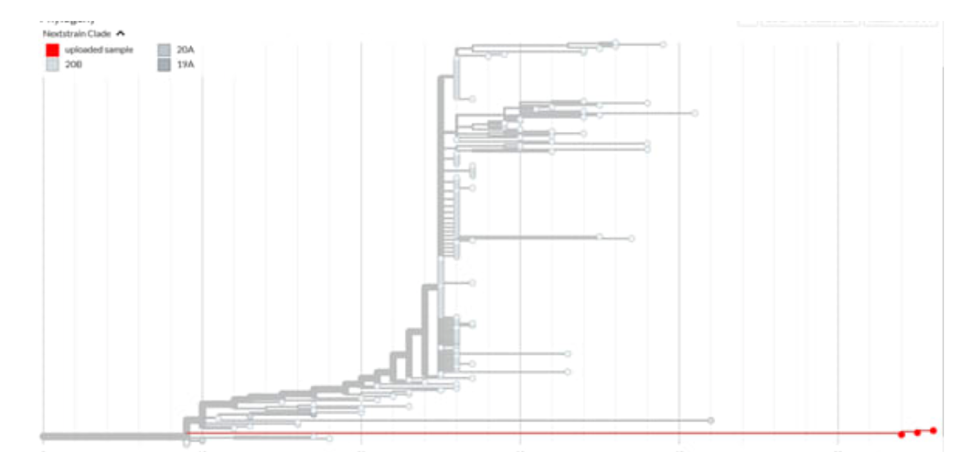 Covering COVID-19 is a daily Poynter briefing of story ideas about the coronavirus and other timely topics for journalists, written by senior faculty Al Tompkins. Sign up here to have it delivered to your inbox every weekday morning.
Covering COVID-19 is a daily Poynter briefing of story ideas about the coronavirus and other timely topics for journalists, written by senior faculty Al Tompkins. Sign up here to have it delivered to your inbox every weekday morning.
I want to start a new week with a call for calm in your coverage of the new coronavirus variant. In the weeks ahead, the public will need to know you are neither hyping nor underplaying the threat. Make room for nuance and uncertainty in your reporting because it takes a couple of weeks to get definitive answers about key issues that I will explore with you today.
If you need a quick read, let me give you some bullet points for Monday:
- The new omicron variant is different in more than 30 ways from the virus we have seen in the past.
- So far, infections from the new variant have produced mild symptoms.
- We do not know yet if the currently approved vaccines protect us a little, a lot or not much at all from this version of the virus, but there is reason to believe the vaccines will provide at least some protection.
- As of today, it appears most of the people infected by the omicron variant were not fully vaccinated.
- The drug companies that made the vaccines are already working on a new version that could be needed to protect against this variant. The new version would not be available until sometime in 2022, if it is needed.
- The variant was first noted by South African researchers, but it has been detected around Europe, Asia, Australia and Africa. South Africa has documented the most cases, but it could be that as other countries — including the United States — look more closely at tests in the week ahead, we will find more cases. Late Sunday, the first two cases turned up in Canada. Health officials in Ontario said both of the positive cases were people who had recently traveled to Canada from Nigeria.
- COVID-19 cases are rising in many states. Almost all of them are from the delta variant.
- We will find out this week if Thanksgiving travel ignited a renewed outbreak, which experts expect.
- The best thing individuals can do right now is what you should have done all along: Get vaccinated, get boosted, wear a mask in crowds, increase ventilation and, if you show symptoms, get tested. If you turn up positive, then isolate.
Meanwhile, my colleague Tom Jones shows you how media around the world are covering the new variant.
How much of a threat is the omicron variant?
Keep the concerns in perspective. So far, cases of this new variant are in the hundreds, not thousands or millions. But within days, you can expect those numbers to rise, and maybe rise fast. In fact, by the time you read this, these figures will be outdated, so click on the chart for the latest.
Health officials in the Netherlands will tell us today if they found new cases among more than 60 people with COVID-19 on a flight from South Africa over the weekend. Dutch airline KLM requires masks but New York Times global health reporter Stephanie Nolen, who was on the flight, tweeted:
BUT ALSO. I am surrounded by MORONS who don’t even have their masks on.
When we’re marooned because of a possibly vaccine-proof variant. WHAT IS WRONG WITH PEOPLE.— Stephanie Nolen (@snolen) November 26, 2021
When one case of a variant shows up, it is an indication that many more are likely out there undetected.
The first cases do not tell us with certainty where the variant may have traveled. It was discovered in Botswana on Nov. 11. It was then identified in South Africa three days later and also in two cases in Hong Kong. The case that traces to Belgium involved an unvaccinated woman who had no links to South Africa. She had gone through Egypt via Turkey.
No cases have shown up in the United States. Dr. Anthony Fauci, the director of the National Institute of Allergy and Infectious Diseases, said he would not be surprised if there are undetected cases already in the United States. We have learned over the last two years that once cases show up, they can spread quickly without constant testing and aggressive public reporting of the new case data.
Why is the variant so different from the others?
The omicron variant is heavily mutated. That means it has found ways to adapt to keep spreading. Scientists looked at those now-familiar spike proteins that you see on the images of the virus and found 32 mutations.
The fast mutations may indicate that this version of the virus will be more easily transmissible, even among vaccinated people or people who have some level of natural immunity from a previous infection.
Usually cool and collected epidemiologist Dr. Katelyn Jetelina explains:
This is an insane amount of change. As a comparison, Delta had 9 changes on the spike protein. We know that Omicron is not a “Delta plus” variant.
Nonetheless, we always pay attention to changes on the spike protein because the spike is the key into our cells. If the virus changes to become a smarter key, we need to know. We are particularly interested in mutations that could do any of the following:
- Increase transmissibility;
- Escape our vaccines or infection-induced immunity; and/or
- Increase severity (hospitalization or death).
Omicron has the potential to do all three. We know this because we’ve seen a number of these mutations on other variants of concern (VOC), like Delta, Alpha, and Gamma.
Think of this graphic as a family tree for viruses. The data released from South Africa shows this variant (in red at the bottom) has no known connection to the delta variant.
The Associated Press quotes virologist Lawrence Young, from the University of Warwick, who describes omicron as “the most heavily mutated version of the virus we have seen,” including potentially worrying changes never before seen all in the same virus.
The World Health Organization says “preliminary evidence suggests an increased risk of reinfection with this variant” in people who have already had Covid-19.” For people who have relied on “natural immunity,” meaning the immune response from having been infected, this is a bright red flag. We may find out soon whether the immune response to previous variants offers some level of protection against omicron.
Dr. Peter Hotez, dean of Baylor’s National School of Tropical Medicine, said on CNN, “This variant does not appear to be causing worse disease than anything we’ve seen before — this is not ‘The Andromeda Strain.’”
Will the vaccines work against omicron?
The real answer is that we do not know yet, but South African virologist Barry Schoub says it appears the vaccines are effective against omicron. He told an Israeli TV station, “Certainly what we’ve been seeing up to now … the great majority of the patients have been mild. In fact, there hasn’t been a very substantial increase in hospital admissions so far.”
Both Pfizer and Moderna said over the weekend that they are testing their mRNA vaccines against the new variant and, if needed, could adapt their vaccines within six weeks and start shipping batches within 100 days.
Pfizer says it should know how effective the current vaccine is against this variant within two weeks.
Moderna announced Sunday that a new version of its vaccine, if needed, could be ready for distribution early in 2022.
AstraZeneca said it is also investigating the variant. Their vaccine is not approved in the United States but is widely used globally.
The AP quotes Peter Openshaw, a professor of experimental medicine at Imperial College London, who says it is “extremely unlikely” that current vaccines wouldn’t work, noting they are effective against other variants.
British Prime Minister Boris Johnson said, after the discovery of the first omicron case in the United Kingdom, that the variant “spreads very rapidly” and can “spread between people who are double vaccinated.”
How many of the 32 variants in omicron are new? Does that make it more dangerous?
Jeffrey Barrett, who leads a genomics initiative called the Wellcome Sanger Institute, produced a chart that shows the many spike mutations.
They don’t mean much to you but once you understand the color code, you get a picture of how much we need to know to understand this new variant. Dr. Katelyn Jetelina offers these definitions:
- Red: This means bad. There are nine mutations on B.1.1.529 that we’ve seen in previous Variants of Concern (VOC). P681R is particularly bad news.
- Purple: These are new mutations (i.e. not seen in other VOC), but we have lab data to suggest they are a threat.
- Yellow: These probably mean something because of their location, but we don’t know what they mean yet. They have not been previously seen in Variants of Concern.
- Blue: We’ve never seen these changes before. They may mean something or may mean nothing. We don’t know yet. We need more data.
- Green: This is a mutation that’s been present on all of the variants since early 2020. Not to be of concern.
Why don’t countries wait to learn more before reacting?
First, keep in mind that travel bans are political moves more than evidence-based actions.
The United States, Canada, European Union countries and the United Kingdom banned travelers from South Africa and adjoining countries even though there is a lot we do not know about omicron. Most countries allow citizens and permanent residents to come home if they test negative for the virus. In some cases, travelers have to also quarantine.
The quick reaction is partly based on month after month of the heel dragging that keeps the pandemic going. The delta variant was a great lesson for us to reflect on right now. We let down on mask-wearing and social distancing just as delta was rising and we spent a summer with full intensive care units. When the delta variant infected India, the world finally reacted in greater force, but it was a long time coming.
New York Gov. Kathy Hochul warned:
We continue to see warning signs of spikes in COVID this winter, and while the new Omicron variant has yet to be detected in New York State, it’s coming.
Today I signed an Executive Order to help @HealthNYGov boost hospital capacity ahead of potential spikes.
— Kathy Hochul (@GovKathyHochul) November 26, 2021
How did they come up with the name of this variant?
Conspiracy theorists and rumormongers have been all over this question this weekend. The New York Times explains:
W.H.O. skipped two letters just before Omicron — “Nu” and “Xi” — leading to speculation about whether “Xi” was avoided in deference to the Chinese president, Xi Jinping.
“‘Nu’ is too easily confounded with ‘new,’” Tarik Jasarevic, a W.H.O. spokesman, said on Saturday. “And ‘Xi’ was not used because it is a common last name.”
He added that the agency’s best practices for naming diseases suggest avoiding “causing offense to any cultural, social, national, regional, professional or ethnic groups.”
Why did the stock market go wild about omicron?
The stock market is not a reliable indication of how concerned you should be about each variant of the coronavirus. Traders do not like surprises and the discovery of a new variant was a surprise.
The markets have a number of concerns that include:
- The potential for new shutdowns that would affect travel, shopping, manufacturing and shipping
- The loss of workers
- The increased cost of testing, worker safety and precautions
- The government(s) have done so much already to keep a pandemic from wrecking the economy. What else might be needed and how expensive would it be?
- A general malaise might set in if we thought we were nearly at the end of the pandemic only to find out we were just at the end of the beginning of it.
This variant is one more reason why it is vital that we ‘think globally’ about vaccines
The World Health Organization makes two key points to begin the week. First, the worst COVID-19 outbreaks now are Eastern European countries where vaccines are sparsely available. Second, the WHO says the “scandal that must stop now” is that more booster shots are being given in wealthy countries around the world compared to first or second doses in poorer countries. As you will recall, the WHO opposed booster shots in the U.S. until more primary vaccinations were available around the globe.
But look at the latest data on new cases around the world. Despite the U.S. and Canada having an abundance of vaccines, we lead many other countries in new cases.
The point is when an outbreak occurs anywhere, it keeps the threat alive for everyone everywhere. Viruses look for unvaccinated hosts to keep going.
Incidentally, South Africa should not be punished for having aggressive testing and alert protocols that detected and reported the new variant. This is the research center that found the variant and reported it, even though it prompted a ban on South African travelers.
We’ll be back tomorrow with a new edition of Covering COVID-19. Are you subscribed? Sign up here to get it delivered right to your inbox.











